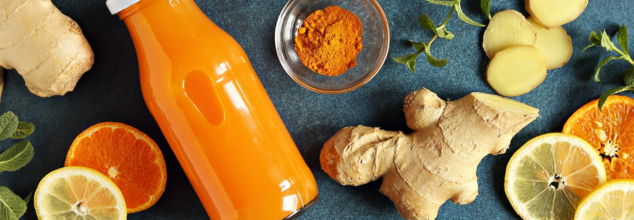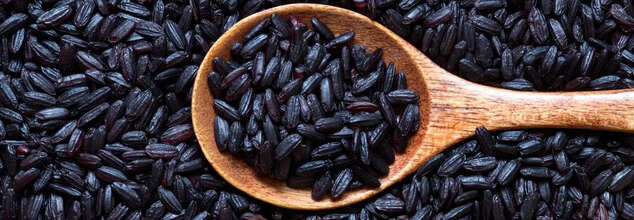
(Credit-Canva)
Are Wellness Shots Worth It?
New health trends are always popping up, whether they are diet related, fitness related, or lifestyle related. Wellness shots are one such trend that has picked up pace. Wellness shots are small drinks that are concentrated with vitamins and minerals from a strong plant compound.
You may have heard of ginger turmeric shots; they are one of the most popular health shots that you may also find in stores along with nutrient-dense herbs, spices, extracts as well as fruits and vegetables. People who incorporate wellness shots into their diets often do so as they feel like these shots can help them avoid diseases and nutrient density. But are these shots all you need to have for good health?
Are Wellness Shots Actually Good For You?
While there are many benefits for each component, there is no clear proof of whether they actually help your health or not. According to the Ohio State University Wexner Medical Center, while there are individual benefits of these shots, they shouldn't replace a balanced diet. Whole foods offer a complex mix of nutrients that work together naturally. Isolating specific benefits, like anti-inflammatory or antioxidant properties, overlooks this natural synergy. While shots can complement a healthy diet, eating a wide variety of nutritious foods is the best approach. Try incorporating ingredients like apple cider vinegar into dressings, ginger into tea, and turmeric into meals whenever possible.
People say wellness shots can do lots of good things, like make your immune system stronger and help your stomach. But, we need more studies to really know if they work as well as people think. Many studies look at pills or powders, not these little juice shots. Also, these shots lose some of their power after a few days in the fridge. So, if they sit on the store shelf for too long, they might not be as helpful. We know the ingredients are good, but we need to learn more about how they work when they're all mixed together in a shot.
Common Ingredients in Wellness Shots
A variety of wellness shots exist, each with unique ingredient combinations targeting different health benefits. Here are some commonly used ingredients:
Ginger: Known for its digestive and anti-inflammatory properties, ginger contains gingerols that can alleviate nausea and vomiting, especially during pregnancy.
Turmeric: Curcumin, its active compound, boasts powerful antioxidant and anti-inflammatory effects, potentially aiding in managing arthritis, metabolic syndrome, anxiety, and muscle soreness. Combining it with black pepper enhances absorption.
Apple Cider Vinegar: May help reduce fasting blood glucose, triglyceride, and total cholesterol levels in individuals with type 2 diabetes.
Acerola Cherry: A natural source of vitamin C, which is readily absorbed by the body, supporting immune function.
Wheatgrass: Rich in antioxidants, it may protect against oxidative stress and the development of chronic diseases.
Elderberry: Possesses antiviral properties that can significantly reduce upper respiratory symptoms.
Green Tea: The combination of L-theanine and caffeine may promote relaxation, reduce stress, improve mood, and enhance focus.
Safety Considerations
Even though they're made from good things, wellness shots can sometimes cause problems. A StatsPearl review explains that ginger and turmeric can thin your blood, which is bad if you take medicine for that. They can also lower your blood sugar too much if you take medicine for diabetes, too much ginger can also upset your stomach. MedlinePlus explains that apple cider vinegar can also lower blood sugar. So, it's important to be careful. If you take any medicine, ask your doctor before you drink these shots. They can tell you if it's safe and if they might mix badly with your medicine. If you start to feel sick after drinking them, stop drinking them.

Credit: Canva
Gluten-Free Black Rice Is Great For Your Eyes-But What Else Does It Offer?
When we talk about rice, we mostly talk about white or brown. However, not many people know that there is a black-purple coloured variant of this called Black rice. Packed with nutrients, this variant owes its purple colour to a pigment called anthocyanin, which has potent antioxidant properties. Intrestingly, in ancient China, black rice was considered so unique and nutritious that it was forbidden for everyone beyond royalty.
What's Special About Black Rice?
1. A Rich Source of Essential Nutrients
Black rice stands out among rice varieties due to its high protein content. In comparison to brown rice, which contains 7 grams of protein per 100 grams, black rice offers 9 grams. It is also a valuable source of iron, a mineral crucial for oxygen transport in the body.A quarter cup (45 grams) of uncooked black rice provides:
Calories: 160
Fat: 1.5 grams
Protein: 4 grams
Carbohydrates: 34 grams
Fiber: 1 gram
Iron: 6% of the Daily Value (DV)
2. High in Antioxidants
Beyond its protein and fiber content, black rice is rich in antioxidants—compounds that help combat oxidative stress and reduce the risk of chronic diseases such as heart disease, Alzheimer’s, and cancer. Studies indicate that black rice has the highest antioxidant activity among rice varieties, containing over 23 beneficial plant compounds, including flavonoids and carotenoids.
3. Contains Anthocyanins for Added Health Benefits
Anthocyanins, the flavonoid pigments responsible for black rice’s dark hue, are known for their potent anti-inflammatory, antioxidant, and anticancer properties. Research suggests that consuming anthocyanin-rich foods can lower the risk of chronic diseases such as heart disease and obesity.
4. Supports Heart Health
Though research on black rice and heart health is ongoing, its flavonoids have been linked to a lower risk of cardiovascular disease. Some studies suggest that anthocyanins can improve cholesterol levels by increasing HDL (good) cholesterol and reducing LDL (bad) cholesterol. While further research is needed, early findings suggest black rice may help reduce plaque buildup in arteries.
5. Potential Anticancer Properties
Black rice’s anthocyanins may also play a role in cancer prevention. Population studies show that higher intake of anthocyanin-rich foods is associated with a reduced risk of colorectal cancer. Additionally, laboratory research suggests that anthocyanins from black rice can inhibit the growth and spread of breast cancer cells. However, more human studies are needed to confirm these effects.
6. Promotes Eye Health
Black rice contains significant amounts of lutein and zeaxanthin, two antioxidants that protect the eyes from damage caused by free radicals. These compounds help filter harmful blue light and may reduce the risk of age-related macular degeneration (AMD), cataracts, and diabetic retinopathy. Animal studies suggest anthocyanins may also protect the retina, though human research is still limited.
7. Naturally Gluten-Free
For individuals with celiac disease or gluten sensitivity, black rice offers a nutritious, gluten-free alternative to many whole grains. It provides essential nutrients without triggering digestive issues associated with gluten-containing grains like wheat, barley, and rye.
8. May Aid in Weight Management
Black rice’s high protein and fiber content can promote satiety, potentially aiding in weight management. Some animal studies suggest that anthocyanins may help reduce body fat, though human studies are still limited. A study found that consuming a mix of black and brown rice led to greater weight loss compared to eating white rice.
9. Additional Health Benefits
May Help Regulate Blood Sugar: Animal studies suggest that black rice may aid in blood sugar control, though human trials are required for confirmation.
Supports Liver Health: Research on mice indicates that black rice may reduce fat accumulation in the liver, potentially lowering the risk of non-alcoholic fatty liver disease (NAFLD).
10. Easy to Cook and Versatile
Cooking black rice is similar to preparing other rice varieties. Simply combine the rice with water or broth, bring it to a boil, then reduce the heat and let it simmer for 30–35 minutes until tender. To achieve a fluffier texture, rinse the rice before cooking to remove excess starch.
Black rice can be used in various dishes, including grain bowls, stir-fries, salads, and desserts like rice pudding.

Pain Relief Without Pills? This Bizarre Brain Hack Could Help
Imagine if pain management didn't need a pill, injection, or surgery—just a simple mind trick. It may sound like a magic trick, but new studies indicate that our brain can be tricked into alleviating pain through a remarkable psychological phenomenon.
A recent paper in the journal Pain Reports documents a strange but powerful method for reducing pain—by an illusion called the Rubber Hand Illusion (RHI). This pioneering research may unlock the door to non-drug therapy for chronic pain, presenting a choice for the millions of victims.
This study shows how strong the brain is in forming our experience of pain. By using the mind's capacity to be deceived through illusions, we can potentially be on the threshold of a new age in pain relief—one that has no need for drugs but rather uses the brain's own neuroplasticity.
What Is the Rubber Hand Illusion?
The Rubber Hand Illusion is a well-known psychological test that deceives the brain into thinking that an artificial hand belongs to the body. In earlier research, subjects were seated with one hand concealed behind a screen and a realistic rubber hand in front of them. When both the real and artificial hands were touched at the same time, most subjects reported feeling the sensations in the rubber hand as if it were their own.
Following this idea, researchers at Ruhr University Bochum in Germany examined whether the illusion would be able to impact pain perception. Rather than touch, they applied heat and light to examine how visual and sensory integration impacts pain perception.
Can Visual Illusions Reduce Pain?
The experiment included 34 subjects who were subjected to a rubber hand that was red-glowing while their concealed actual hand was provided with heat stimuli of varying warmth to the level of pain. The subjects then rated their pain on a scale with their other hand.
The control group received the rubber hand in an upside-down position, and this interfered with the body ownership illusion. The outcomes were dramatic: when participants saw the rubber hand in its appropriate position, they responded with significantly decreased pain levels—sometimes within a mere 1.5 seconds after the illusion had been induced. This pain reduction continued during the experiment, showing a clear connection between the illusion and pain regulation.
One of the most important insights that emerge from this research is that of visual analgesia—a situation where mere observation of a part of the body in pain will alleviate the discomfort. What this finding implies is that how we perceive our bodies visually has an important function to play in the alleviation of pain.
The findings suggest that when individuals feel the rubber hand is their own, their brain recalibrates its reaction to pain accordingly, said lead researcher Martin Diers. Although the precise neural mechanisms involved in this process are not yet understood, the research paves the way for further investigation into how the brain combines visual and sensory information.
Does this Drug-Free Method Help in Pain Relief?
With the ever-present opioid crisis and growing fears over the side effects of pain medication, finding alternative pain relief options is more important than ever. Chronic pain harms millions globally and common painkillers often involve risks like addiction, tolerance build-up, and adverse side effects.
The Rubber Hand Illusion provides a fascinating, non-surgical means to potentially treat pain without medication. As this study is in its infancy, however, there is potential for implications. Healthcare professionals might include illusion-based treatment in pain therapies if further research establishes these findings. Patients suffering from arthritis, fibromyalgia, or neuropathic pain could benefit.
Could This Lead to Better Pain Treatments?
Though the Rubber Hand Illusion is not yet a widely accepted treatment, its success implies that other mind-body interventions like it have the potential to transform pain therapy. Future research can look into means of amplifying the illusion's analgesic effect, potentially with virtual reality (VR) or augmented reality (AR) platforms.
For example, VR technology might transport the user into a world where he or she "sees" the hurt limb healing or senses lower levels of pain through deception. These technologies might make feasible, home-based therapies for the chronically ailing.

Image Credits: Canva
Morning Habits That Make Sure Your Cortisol Levels Stay Under Control Throughout The Day
Everybody has a unique way of going about their morning routine, while some people enjoy being up early, getting chores done before going about their day and others like sleeping till late for as long as they can and then rush through their routine to reach office on time.
Even from general observation, one can tell that the better way is to wake up early as rushing every morning seems very exhausting. Waking up early has a big impact on your hormones, especially cortisol. Keeping this rhythm steady is important for your overall health, and your morning habits play a key role in how well your body manages this hormone.
WebMD explains Cortisol is like your body's natural alarm clock and stress manager. When it's working right, it helps control your daily rhythm, like when you feel awake and sleepy. It when it's out of balance, it can cause problems. If you have too much cortisol for too long, you might feel anxious, gain weight, have high blood pressure, or struggle to sleep. On the flip side, too little cortisol can make you feel tired, have low blood pressure, and make it hard to handle stress. Research has also shown that long-term problems with cortisol can even increase your risk of serious illnesses like Alzheimer's or depression. A big reason for this imbalance is often chronic stress, which many people deal with daily.
Habits That Ensure Healthy Cortisol Levels
Maintain a Consistent Wake-Up Time
Your body thrives on routine, especially for sleep. Regular bed and wake times keep your internal clock steady, which helps manage cortisol. Weekends can tempt you to sleep in, but it mixes up your hormones. A steady schedule tells your body when to expect energy and rest. Aim for seven to nine hours of sleep nightly. This consistent rhythm aids in proper cortisol regulation, keeping you balanced.
Engage in Mindful Movement
Morning exercise has added benefits. It matches your body's natural cortisol rise, boosting alertness. Studies show it can also lower overall cortisol, improving sleep. You don't need intense workouts; gentle activities like yoga or walks are great. These movements relax your mind and body, preventing cortisol spikes. They provide a healthy energy boost, starting your day calmly without overwhelming your system.
Embrace Morning Sunlight
Sunlight is key for your body's internal clock. Morning sun tells your body it's time to wake up, helping regulate cortisol. Just 15 to 30 minutes of sun can increase energy and alertness. Combine outdoor movement with sunlight for extra benefits. Walk in the park, do yoga outside, or stretch on your porch. This mix of exercise and sun significantly aids cortisol management, keeping you feeling good.
Consume a Balanced Breakfast
Breakfast isn't just fuel; it affects cortisol. Skipping it can disrupt your morning cortisol rhythm, potentially causing health issues like metabolic problems. A good breakfast includes proteins, healthy fats, and complex carbs. This mix stabilizes blood sugar, preventing energy dips and stress hormone surges. When your body lacks fuel, it releases extra cortisol, which is bad for balance. A balanced breakfast sets you up for a stable, less stressful day.
© 2024 Bennett, Coleman & Company Limited

